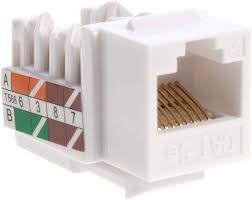A "keystone CAT5" typically refers to a keystone jack specifically designed for CAT5 cables. Keystone jacks are modular connectors used in networking installations to terminate twisted pair cables, such as CAT5, CAT5e, or CAT6 cables, at wall outlets, patch panels, or faceplates.
Here's what "keystone CAT5" entails:
1. **Keystone Jack:** A keystone jack is a modular connector that snaps into a compatible faceplate, patch panel, or surface mount box. It provides a termination point for network cables, allowing them to be easily connected and disconnected.
2. **CAT5:** CAT5 refers to Category 5 cabling, which is a type of twisted pair cable commonly used in Ethernet networking. CAT5 cables support data rates up to 100 Mbps and frequencies of up to 100 MHz.
3. **Compatibility:** A keystone CAT5 jack is specifically designed to terminate CAT5 cables. It provides a standardized connection point for CAT5 cables, ensuring compatibility with other networking equipment and components.
4. **Color Coding:** Keystone jacks often follow a color-coding standard to help identify the type of cable they are designed for. For example, a keystone CAT5 jack may be color-coded blue to indicate its compatibility with CAT5 cables.
5. **Termination Method:** Keystone CAT5 jacks typically use punch-down termination, where the individual wires of the CAT5 cable are inserted into slots on the jack and punched down using a punch-down tool to establish electrical connections.
In summary, a "keystone CAT5" is a modular keystone jack designed specifically for terminating CAT5 cables in networking installations. It provides a standardized connection point for CAT5 cables and is commonly used in residential, commercial, and industrial Ethernet networking setups.
